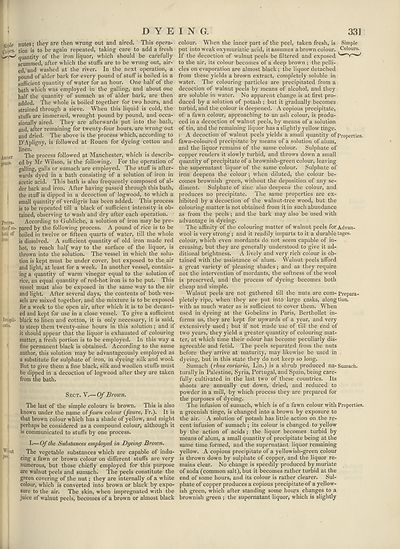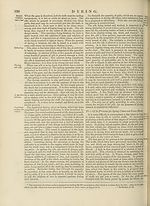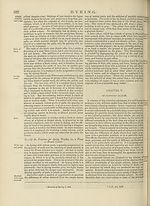Encyclopaedia Britannica > Volume 8, DIA-England
(341) Page 331
Download files
Complete book:
Individual page:
Thumbnail gallery: Grid view | List view

i DYE
Sinle nutes; they are then wrung out and aired. This opera-
Co irs. tion is to be again repeated, taking care to add a fresh
^ ^ quantity of the iron liquor, which should be carefully
scummed, after which the stuffs are to be wrung out, air¬
ed, and washed at the river. In the next operation, a
pound of alder bark for every pound of stuff is boiled in a
sufficient quantity of water for an hour. One half of the
bath which was employed in the galling, and about one
half the quantity of sumach as of alder bark, are then
added. The whole is boiled together for two hours, and
strained through a sieve. When this liquid is cold, the
stuffs are immersed, wrought pound by pound, and occa¬
sionally aired. They are afterwards put into the bath,
and, after remaining for twenty-four hours, are wrung out
and dried. The above is the process which, according to
D’Apligny, is followed at Rouen for dyeing cotton and
linen.
^nf er The process followed at Manchester, which is describ-
proc s- ed by Mr Wilson, is the following. For the operation of
galling, galls or sumach are employed. The stuff is after¬
wards dyed in a bath consisting of a solution of iron in
acetic acid. This bath is also frequently composed of al¬
der bark and iron. After having passed through this bath,
the stuff is dipped in a decoction of logwood, to which a
small quantity of verdigris has been added. This process
is to be repeated till a black of sufficient intensity is ob¬
tained, observing to wash and dry after each operation.
prf.;ra. According to Guhliche, a solution of iron may be pre-
tionfso- pared by the following process. A pound of rice is to be
lutL of boiled in twelve or fifteen quarts of water, till the whole
‘ro1 is dissolved. A sufficient quantity of old iron made red
hot, to reach half way to the surface of the liquor, is
thrown into the solution. The vessel in which the solu¬
tion is kept must be under cover, but exposed to the, air
and light, at least for a week. In another vessel, contain¬
ing a quantity of warm vinegar equal to the solution of
rice, an equal quantity of red-hot iron is to be put. This
vessel must also be exposed in the same way to the air
and light. After several days, the contents of both ves¬
sels are mixed together, and the mixture is to be exposed
for a week to the open air, after which it is to be decant¬
ed and kept for use in a close vessel. To give a sufficient
Itsupli- black to linen and cotton, it is only necessary, it is said,
cattl> to steep them twenty-nine hours in this solution; and if
it should appear that the liquor is exhausted of colouring
matter, a fresh portion is to be employed. In this way a
fine permanent black is obtained. According to the same
author, this solution may be advantageously employed as
a substitute for sulphate of iron, in dyeing silk and wool.
But to give them a fine black, silk and woollen stuffs must
be dipped in a decoction of logwood after they are taken
from the bath.
Sect. V.— Of Brown.
The last of the simple colours is browm. This is also
known under the name of fawn colour (fauve, Fr.). It is
that brown colour which has a shade of yellow, and might
perhaps be considered as a compound colour, although it
is communicated to stuffs by one process.
I.—Of the Substances employed in Dyeing Brown.
" ut The vegetable substances which are capable of indu-
lie' cing a fawn or brown colour on different stuffs are very
numerous, but those chiefly employed for this purpose
are walnut peels and sumach. The peels constitute the
green covering of the nut; they are internally of a white
colour, which is converted into brown or black by expo¬
sure to the air. The skin, when impregnated with the
juice of walnut peels, becomes of a brown or almost black
I N G. 331
colour. When the inner part of the peel, taken fresh, is Simple
put into weak oxymuriatic acid, it assumes a brown colour. Colours.
If the decoction of walnut peels be filtered and exposed
to the air, its colour becomes of a deep brown ; the pelli¬
cles on evaporation are almost black ; the liquor detached
from these yields a brown extract, completely soluble in
water. The colouring particles are precipitated from a
decoction of walnut peels by means of alcohol, and they
are soluble in water. No apparent change is at first pro¬
duced by a solution of potash ; but it gradually becomes
turbid, and the colour is deepened. A copious precipitate,
of a fawn colour, approaching to an ash colour, is produ¬
ced in a decoction of walnut peels, by means of a solution
of tin, and the remaining liquor has a slightly yellow tinge,
i A decoction of walnut peels yields a small quantity of Properties,
fawn-coloured precipitate by means of a solution of alum,
and the liquor remains of the same colour. Sulphate of
copper renders it slowly turbid, and throws down a small
quantity of precipitate of a brownish-green colour, leaving
the supernatant liquor of the same colour. Sulphate of
iron deepens the colour; when diluted, the colour be¬
comes brownish green, without the deposition of any se¬
diment. Sulphate of zinc also deepens the colour, and
produces no precipitate. The same properties are ex¬
hibited by a decoction of the walnut-tree wood, but the
colouring matter is not obtained from it in such abundance
as from the peels; and the bark may also be used with
advantage in dyeing.
The affinity of the colouring matter of walnut peels for Advan-
wool is very strong ; and it readily imparts to it a durable tages.
colour, which even mordants do not seem capable of in¬
creasing, but they are generally understood to give it ad¬
ditional brightness. A lively and very rich colour is ob¬
tained with the assistance of alum. Walnut peels afford
a great variety of pleasing shades; and as they require
not the intervention of mordants, the softness of the wool
is preserved, and the process of dyeing becomes both
cheap and simple.
Walnut peels are not gathered till the nuts are com- Prepara-
pletely ripe, when they are put into large casks, along tion.
with as much water as is sufficient to cover them. When
used in dyeing at the Gobelins in Paris, Berthollet in¬
forms us, they are kept for upwards of a year, and very
extensively used; but if not made use of till the end of
two years, they yield a greater quantity of colouring mat¬
ter, at which time their odour has become peculiarly dis¬
agreeable and fetid. The peels separated from the nuts
before they arrive at maturity, may likewise be used in
dyeing, but in this state they do not keep so long.
Sumach {rkus coriaria, Lin.) is a shrub produced na- Sumach,
turally in Palestine, Syria, Portugal, and Spain, being care¬
fully cultivated in the last two of these countries. Its
shoots are annually cut down, dried, and reduced to
powder in a mill, by which process they are prepared for
the purposes of dyeing.
The infusion of sumach, which is of a fawn colour with Properties,
a greenish tinge, is changed into a brown by exposure to
the air. A solution of potash has little action on the re¬
cent infusion of sumach ; its colour is changed to yellow
by the action of acids; the liquor becomes turbid by
means of alum, a small quantity of precipitate being at the
same time formed, and the supernatant liquor remaining
yellow. A copious precipitate of a yellowish-green colour
is thrown down by sulphate of copper, and the liquor re¬
mains clear. No change is speedily produced by muriate
of soda (common salt), but it becomes rather turbid at the
end of some hours, and its colour is rather clearer. Sul¬
phate of copper produces a copious precipitate of a yellow¬
ish green, which after standing some hours changes to a
brownish green ; the supernatant liquor, which is slightly
Sinle nutes; they are then wrung out and aired. This opera-
Co irs. tion is to be again repeated, taking care to add a fresh
^ ^ quantity of the iron liquor, which should be carefully
scummed, after which the stuffs are to be wrung out, air¬
ed, and washed at the river. In the next operation, a
pound of alder bark for every pound of stuff is boiled in a
sufficient quantity of water for an hour. One half of the
bath which was employed in the galling, and about one
half the quantity of sumach as of alder bark, are then
added. The whole is boiled together for two hours, and
strained through a sieve. When this liquid is cold, the
stuffs are immersed, wrought pound by pound, and occa¬
sionally aired. They are afterwards put into the bath,
and, after remaining for twenty-four hours, are wrung out
and dried. The above is the process which, according to
D’Apligny, is followed at Rouen for dyeing cotton and
linen.
^nf er The process followed at Manchester, which is describ-
proc s- ed by Mr Wilson, is the following. For the operation of
galling, galls or sumach are employed. The stuff is after¬
wards dyed in a bath consisting of a solution of iron in
acetic acid. This bath is also frequently composed of al¬
der bark and iron. After having passed through this bath,
the stuff is dipped in a decoction of logwood, to which a
small quantity of verdigris has been added. This process
is to be repeated till a black of sufficient intensity is ob¬
tained, observing to wash and dry after each operation.
prf.;ra. According to Guhliche, a solution of iron may be pre-
tionfso- pared by the following process. A pound of rice is to be
lutL of boiled in twelve or fifteen quarts of water, till the whole
‘ro1 is dissolved. A sufficient quantity of old iron made red
hot, to reach half way to the surface of the liquor, is
thrown into the solution. The vessel in which the solu¬
tion is kept must be under cover, but exposed to the, air
and light, at least for a week. In another vessel, contain¬
ing a quantity of warm vinegar equal to the solution of
rice, an equal quantity of red-hot iron is to be put. This
vessel must also be exposed in the same way to the air
and light. After several days, the contents of both ves¬
sels are mixed together, and the mixture is to be exposed
for a week to the open air, after which it is to be decant¬
ed and kept for use in a close vessel. To give a sufficient
Itsupli- black to linen and cotton, it is only necessary, it is said,
cattl> to steep them twenty-nine hours in this solution; and if
it should appear that the liquor is exhausted of colouring
matter, a fresh portion is to be employed. In this way a
fine permanent black is obtained. According to the same
author, this solution may be advantageously employed as
a substitute for sulphate of iron, in dyeing silk and wool.
But to give them a fine black, silk and woollen stuffs must
be dipped in a decoction of logwood after they are taken
from the bath.
Sect. V.— Of Brown.
The last of the simple colours is browm. This is also
known under the name of fawn colour (fauve, Fr.). It is
that brown colour which has a shade of yellow, and might
perhaps be considered as a compound colour, although it
is communicated to stuffs by one process.
I.—Of the Substances employed in Dyeing Brown.
" ut The vegetable substances which are capable of indu-
lie' cing a fawn or brown colour on different stuffs are very
numerous, but those chiefly employed for this purpose
are walnut peels and sumach. The peels constitute the
green covering of the nut; they are internally of a white
colour, which is converted into brown or black by expo¬
sure to the air. The skin, when impregnated with the
juice of walnut peels, becomes of a brown or almost black
I N G. 331
colour. When the inner part of the peel, taken fresh, is Simple
put into weak oxymuriatic acid, it assumes a brown colour. Colours.
If the decoction of walnut peels be filtered and exposed
to the air, its colour becomes of a deep brown ; the pelli¬
cles on evaporation are almost black ; the liquor detached
from these yields a brown extract, completely soluble in
water. The colouring particles are precipitated from a
decoction of walnut peels by means of alcohol, and they
are soluble in water. No apparent change is at first pro¬
duced by a solution of potash ; but it gradually becomes
turbid, and the colour is deepened. A copious precipitate,
of a fawn colour, approaching to an ash colour, is produ¬
ced in a decoction of walnut peels, by means of a solution
of tin, and the remaining liquor has a slightly yellow tinge,
i A decoction of walnut peels yields a small quantity of Properties,
fawn-coloured precipitate by means of a solution of alum,
and the liquor remains of the same colour. Sulphate of
copper renders it slowly turbid, and throws down a small
quantity of precipitate of a brownish-green colour, leaving
the supernatant liquor of the same colour. Sulphate of
iron deepens the colour; when diluted, the colour be¬
comes brownish green, without the deposition of any se¬
diment. Sulphate of zinc also deepens the colour, and
produces no precipitate. The same properties are ex¬
hibited by a decoction of the walnut-tree wood, but the
colouring matter is not obtained from it in such abundance
as from the peels; and the bark may also be used with
advantage in dyeing.
The affinity of the colouring matter of walnut peels for Advan-
wool is very strong ; and it readily imparts to it a durable tages.
colour, which even mordants do not seem capable of in¬
creasing, but they are generally understood to give it ad¬
ditional brightness. A lively and very rich colour is ob¬
tained with the assistance of alum. Walnut peels afford
a great variety of pleasing shades; and as they require
not the intervention of mordants, the softness of the wool
is preserved, and the process of dyeing becomes both
cheap and simple.
Walnut peels are not gathered till the nuts are com- Prepara-
pletely ripe, when they are put into large casks, along tion.
with as much water as is sufficient to cover them. When
used in dyeing at the Gobelins in Paris, Berthollet in¬
forms us, they are kept for upwards of a year, and very
extensively used; but if not made use of till the end of
two years, they yield a greater quantity of colouring mat¬
ter, at which time their odour has become peculiarly dis¬
agreeable and fetid. The peels separated from the nuts
before they arrive at maturity, may likewise be used in
dyeing, but in this state they do not keep so long.
Sumach {rkus coriaria, Lin.) is a shrub produced na- Sumach,
turally in Palestine, Syria, Portugal, and Spain, being care¬
fully cultivated in the last two of these countries. Its
shoots are annually cut down, dried, and reduced to
powder in a mill, by which process they are prepared for
the purposes of dyeing.
The infusion of sumach, which is of a fawn colour with Properties,
a greenish tinge, is changed into a brown by exposure to
the air. A solution of potash has little action on the re¬
cent infusion of sumach ; its colour is changed to yellow
by the action of acids; the liquor becomes turbid by
means of alum, a small quantity of precipitate being at the
same time formed, and the supernatant liquor remaining
yellow. A copious precipitate of a yellowish-green colour
is thrown down by sulphate of copper, and the liquor re¬
mains clear. No change is speedily produced by muriate
of soda (common salt), but it becomes rather turbid at the
end of some hours, and its colour is rather clearer. Sul¬
phate of copper produces a copious precipitate of a yellow¬
ish green, which after standing some hours changes to a
brownish green ; the supernatant liquor, which is slightly
Set display mode to:
![]() Universal Viewer |
Universal Viewer | ![]() Mirador |
Large image | Transcription
Mirador |
Large image | Transcription
Images and transcriptions on this page, including medium image downloads, may be used under the Creative Commons Attribution 4.0 International Licence unless otherwise stated. ![]()
| Encyclopaedia Britannica > Encyclopaedia Britannica > Volume 8, DIA-England > (341) Page 331 |
|---|
| Permanent URL | https://digital.nls.uk/193327438 |
|---|
| Attribution and copyright: |
|
|---|
| Description | Ten editions of 'Encyclopaedia Britannica', issued from 1768-1903, in 231 volumes. Originally issued in 100 weekly parts (3 volumes) between 1768 and 1771 by publishers: Colin Macfarquhar and Andrew Bell (Edinburgh); editor: William Smellie: engraver: Andrew Bell. Expanded editions in the 19th century featured more volumes and contributions from leading experts in their fields. Managed and published in Edinburgh up to the 9th edition (25 volumes, from 1875-1889); the 10th edition (1902-1903) re-issued the 9th edition, with 11 supplementary volumes. |
|---|---|
| Additional NLS resources: |
|

